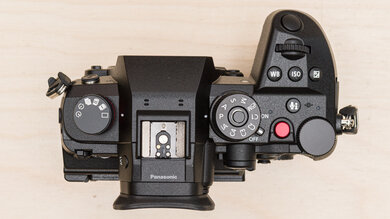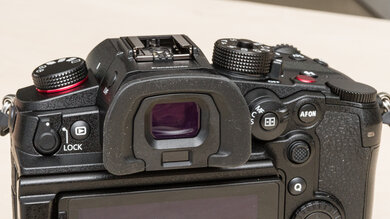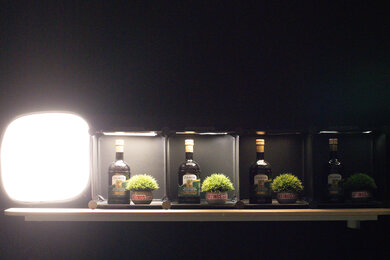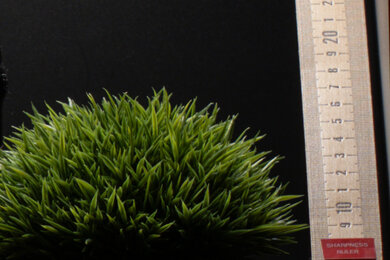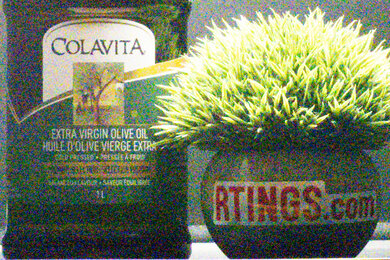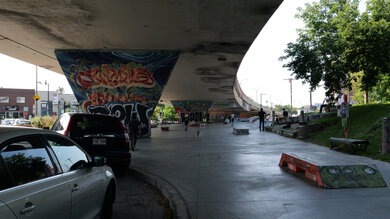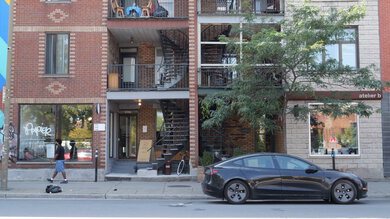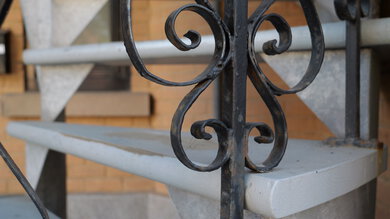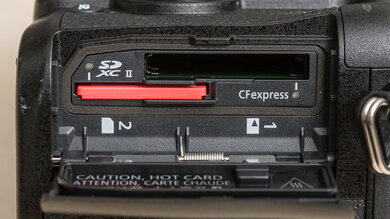If you thought Micro Four Thirds (MFT) was dead, Panasonic is here to remind you why there's life to the system yet. The Panasonic LUMIX GH7 is the follow-up to the Panasonic LUMIX GH6 and one of the most advanced MFT cameras yet. Using a new backside-illuminated (BSI) sensor and implementing the same phase-detection autofocus (AF) system we saw on the Panasonic LUMIX G9 II, it does away with one of the biggest downsides users had with older generations of the GH: outdated contrast-detection autofocus. Add to that some impressive video features, like internal ProRes RAW video support, the capacity to record 32-bit float audio with Panasonic's DMW-XLR2 adapter, and optional ARRI LogC3 support (at additional cost), and the Panasonic GH7 makes a compelling case for the continued longevity of the MFT system, especially for videographers and hybrid shooters.
Our Verdict
The Panasonic LUMIX GH7 isn't designed for travel photography, although it's a capable stills camera. While Micro Four Thirds lenses are typically compact and well-suited for travel, the GH7 camera body isn't especially portable, though it does have excellent ergonomics and plenty of customizable controls. On top of that, it has a decent battery life, is very well-built, and captures great image quality.
-
High-resolution Micro 4/3 sensor.
-
Rated to be splashproof, dustproof, and freezeproof.
-
Bulky and heavy for travel.
The Panasonic LUMIX GH7 captures great landscape photos, though this isn't its main intended use. Its high-resolution MFT sensor resolves a good amount of fine detail and has excellent dynamic range thanks to its Dynamic Range Boost technology. However, it isn't the best option for low-light landscapes. It's also relatively bulky and heavy, making it more of a hassle for longer hikes and shooting days at remote locations. Thankfully, though, it's very well-built and feels comfortable to shoot with.
-
High-resolution Micro 4/3 sensor.
-
Excellent dynamic range.
-
Rated to be splashproof, dustproof, and freezeproof.
-
Noise handling is just okay.
-
Bulky and heavy for travel.
The Panasonic GH7 is a great choice for sports and wildlife photography despite being a more video-centric camera. Micro Four Thirds lenses are more portable than their full-frame counterparts, especially longer telephoto lenses, which is great for shooting far-away subjects. The camera also has a solid autofocus system, with various subject detection modes and more precise tracking settings, though it isn't the most reliable AF on the market. Beyond that, the camera offers very quick burst shooting options and has a large photo buffer, though it takes a very long time to empty the buffer once it's full.
-
High-resolution Micro 4/3 sensor.
-
Quick burst shooting.
-
Relatively large image buffer.
-
Buffer is slow to empty when full.
The Panasonic LUMIX GH7 captures good RAW image quality. Its excellent dynamic range preserves a wider tonal range in high-contrast scenes. It also resolves plenty of fine detail, thanks to its high-resolution sensor. However, its low-light noise management is just okay.
-
High-resolution Micro 4/3 sensor.
-
Excellent dynamic range.
-
Noise handling is just okay.
The Panasonic GH7 is decent for vlogging, especially in a studio or single location, but it's on the bulkier side for on-the-go vlogs. Despite that, it's an incredibly capable video camera, with a very wide range of video recording options and advanced video features like internal ProRes RAW, open gate 5.8k recording, and a built-in fan to prevent overheating and allow for unlimited recording times. It also has an excellent in-body image stabilization system for smoother handheld shots.
-
5.8k open gate at up to 30 fps.
-
4k at up to 120 fps and 1080p at up to 240 fps with no crop and audio.
-
Built-in fan and heat vents.
-
Tilting/articulating screen.
-
Class-leading IBIS.
-
Not portable enough for on-the-go vlogging.
The Panasonic LUMIX GH7 is incredible for studio video. It's chock-full of useful video features, with a design that caters to more advanced videographers. That includes a built-in fan and heat vents to prevent overheating, tally lights, a tilting/articulating screen, class-leading in-body image stabilization (IBIS), a CFexpress card slot, and a full-sized HDMI port. The camera can record 5.8k open gate, internal ProRes RAW, 4k at up to 120 fps, and 1080p at up to 240 fps with audio. Plus, it supports internal 10-bit 4:2:2 capture and V-Log recording. It can also record 32-bit float audio when paired with Panasonic's XLR2 adapter. You can also buy a software key at an additional cost that enables ARRI LogC3 support to color match with ARRI cameras.
-
5.8k open gate at up to 30 fps.
-
4k at up to 120 fps and 1080p at up to 240 fps with no crop and audio.
-
Internal ProRes RAW, ProRes 422, and ProRes 422 HQ.
-
Built-in fan and heat vents.
-
Extra features like 32-bit float audio (with DMW-XLR2) and ARRI LogC3 support (at additional cost).
-
Noise handling is just okay.
The Panasonic GH7 isn't ideal for POV-style action video, but it's a remarkably capable video camera. It offers a very wide range of frame rate options, video recording formats, and codecs, and it's built like a tank and doesn't overheat.
-
5.8k open gate at up to 30 fps.
-
4k at up to 120 fps and 1080p at up to 240 fps with no crop and audio.
-
Built-in fan and heat vents.
-
Tilting/articulating screen.
-
Class-leading IBIS.
-
Not intended for POV action video.
- 7.6 Travel Photography
- 8.0 Landscape Photography
- 7.9 Sport & Wildlife Photography
- 7.8 Raw Photo Performance
- 7.3 Vlogging
- 9.2 Studio Video
- 6.6 Action Video
- Updated Sep 26, 2024: Review published.
- Updated Sep 19, 2024: Early access published.
- Updated Sep 09, 2024: Our testers have started testing this product.
- Updated Aug 29, 2024: The product has arrived in our lab, and our testers will start evaluating it soon.
- Updated Aug 19, 2024: We've purchased the product and are waiting for it to arrive in our lab.
Differences Between Sizes And Variants
The Panasonic GH7 comes in one color: 'Black.' Here's the label for the unit we purchased.
You can buy the camera body on its own or bundled with a lens like the Panasonic Leica DG Vario-Elmarit 12-60mm f/2.8-4 ASPH. POWER O.I.S. lens.
Compared To Other Cameras
The Panasonic LUMIX GH7 is one of the most capable Micro Four Thirds cameras currently on the market, especially for videographers. While there are many reasons one might prefer to buy a full-frame model with similar video features, like the Panasonic LUMIX S5 IIx, especially considering that the GH7 body isn't much more portable, there are just as many reasons to consider Micro Four Thirds with the GH7. Better IBIS and rolling shutter performance, smaller and lighter (and typically more affordable) lenses, and new features, like 32-bit float capability and optional ARRI LogC3 support, set this camera apart.
For other options, check out our recommendations for the best video cameras, the best cameras for YouTube, or the best digital cameras we've tested overall.
The Panasonic LUMIX G9 II and the Panasonic LUMIX GH7 are both fantastic Micro Four Thirds cameras, with different intended users. The G9 II is a great hybrid camera, with some pretty advanced video features, but it's the better option for photography, with a slightly more portable body and simpler feature set. The GH7 is the more advanced video camera, with more advanced internal recording options like internal RAW recording and video-oriented design features, like a CFexpress card slot and a built-in fan to prevent overheating during longer recording sessions.
The Panasonic LUMIX S5 II and the Panasonic LUMIX GH7 are both great cameras, especially for videographers and hybrid shooters. The S5 II uses a full-frame sensor with better noise handling, so it's better-suited to low-light shooting. However, the GH7 offers more portable Micro Four Thirds lenses and has more advanced internal video recording capability overall.
The Panasonic LUMIX GH7 is the successor to the Panasonic LUMIX GH6. While the GH6 is a great video-centric camera in its own right, the GH7 surpasses it in some key ways. One of the biggest improvements is a new phase-detection autofocus system that significantly outperforms the GH6's older contrast-based system. The GH7 also has additional upgrades that cater to more advanced shooters, like internal RAW recording and the capacity to record 32-bit float audio (when using Panasonic's DMW-XLR2 adapter).
Test Results
The Panasonic GH7 is on the bulkier side. Make no mistake, this is a hefty camera. Considering its MFT sensor, there isn't really a portability advantage compared to many larger-sensor bodies. That said, you'll still have more portable lenses to choose from, and the camera's size is well-suited to videography, especially considering the larger size of cine cameras.
The Panasonic LUMIX GH7 feels incredibly well-built. It's a beast of a camera, with a solid body made of magnesium alloy and hard plastic. The buttons and dials all feel sturdy but are still responsive, while the inputs and outputs are covered by hinged rubber doors and flaps. The battery compartment and memory card slots are covered by locking hinged doors that feel secure, and the screen, which has both a tilting mechanism and full articulation, works well and feels solid. Behind the screen is a built-in fan and heat vents to dissipate heat and prevent overheating. The camera is also advertised to be splash-, dust-, and freeze-resistant (down to -10º C / 14º F).
The ergonomics on this camera are fantastic. The body is nearly identical to the Panasonic LUMIX GH6, with a large, well-molded handgrip and textured finish. There are plenty of dedicated buttons, dials, and switches, all well-placed and easy to reach, and the controls are fully customizable, so you can tailor everything to your preferences. Video shooters will appreciate the two tally lights on both the front and back of the camera, as well as two dedicated video record buttons (in addition to the shutter button). That said, the shoulder strap attachment points aren't fixed, so they can rattle around or get in the way, and the rear control dial near the thumb rest protrudes in a way that makes it easy to turn and change settings accidentally. A dedicated video mode switch would also be nice, rather than having the video mode on the PSAM dial, which means having to dive into the menu to set your video shooting mode. However, these are small quibbles, and the overall ergonomics make for a very comfortable and customizable shooting experience.
Like its predecessor, the Panasonic GH7 has an excellent tilting and articulating screen that lets you shoot at various angles but can also tilt away from the body. This ensures the screen doesn't get in the way when you have videography peripherals connected and gives you more flexibility with vertical shots and waist-level shooting when taking photos using the monitor. It has a high resolution and gets remarkably bright, too.
The LUMIX menu system is fantastic. Settings are clearly organized and labeled, making it easy to find what you're looking for. You can also create a custom menu for all of your most-used settings, and there are plenty of customization options and quality-of-life touches. For example, when selecting from the many resolution and frame rate options, you can filter the settings by resolution, frame rate, or codec to more easily find the settings you need. The menu also remembers where you left off, so you can quickly go back and re-adjust the same setting without having to find it again. That said, more advanced settings, like HDMI output settings, can be a bit hard to find, and the quick menu is somewhat limited, although you can still customize it to your liking.
In addition to the old LUMIIX Sync app, the Panasonic GH7 is compatible with the new LUMIX Lab app that was introduced alongside the Panasonic LUMIX S9. LUMIX Lab promises faster transfers between the camera and your smartphone, as well as offering in-app editing and custom LUT creation. You'll have to use LUMIX Sync for remote shooting, but Panasonic advertises that LUMIX Lab will receive remote shooting functionality in a future update.
The Panasonic LUMIX GH7 uses a "newly developed" backside-illuminated (BSI) 25.2 MP Micro Four Thirds sensor. It's similar to the sensor used by the Panasonic LUMIX G9 II, but Panasonic confirmed in a Live Q&A that they are different sensors.
The sensor makes use of Panasonic's 'Dynamic Range Boost' functionality to offer approximately one stop of added dynamic range, for an advertised max of 13+ stops when recording video in V-Log. 'DR Boost' works by combining two different gain readouts into a single exposure. It's applied automatically and operates across the entire ISO range, unlike the Panasonic LUMIX GH6, which only allows 'DR Boost' to be enabled at ISO 800 and higher, effectively limiting the base ISO to 800. However, it still has a few limitations; it's only available in video mode at frame rates up to 60 fps and in stills at shutter speeds faster than 1/15s, and it's also disabled when using the 'SH' burst mode.
Like the GH6 and the G9 II, the GH7 also features a 'High Resolution' photo mode that shifts the sensor in tiny increments for a series of frames and then combines those frames in-camera into a composite image with a resolution of up to 100 megapixels, depending on your quality and aspect ratio settings. There's both a 'Handheld High-Res' mode and a standard 'High Resolution' mode that's intended to be used with a tripod. Here's a handheld 100 MP sample image, compared to the same scene in standard resolution.
The Panasonic GH7 has a decent overall battery life. Its CIPA-rated battery life in photos is okay, but your mileage will vary drastically depending on your settings and what lens you use. For instance, the advertised rating of 330 shots is when using a CFexpress card and the LUMIX G 12-60mm f/2.8-4 lens, but using an SDXC card bumps the rating up to 360 while writing to an external SSD drops the rating down to 280. Those numbers go up respectively to 350 shots, 380 shots, or 290 shots when paired with the LUMIX G 12-60mm f/3.5-5.6. You can also approximately double these numbers by setting the camera's time to sleep to 1s. What all that means is you should take these CIPA ratings with a grain of salt.
In video mode, the camera can record continuously in 4k for about 1.5 hours before the battery dies. This, too, will vary depending on your settings and shooting conditions. If you need to extend the camera's battery life, you can also power it externally with a compatible power supply via USB-C. To that end, Panasonic even sells its own compatible dummy battery, which is required if you want to record video to an external SSD at frame rates higher than 60 fps.
The camera has a wide range of continuous shooting options, including 'H,' 'M,' and 'L' for High, Medium, and Low speed burst shooting. In addition, it has three super high-speed burst modes that use the electronic shutter, which you can set to 'SH75,' 'SH60,' and 'SH20' for bursts of 75, 60, or 20 fps respectively. SH modes can't be used with Live View, and the 'SH75' setting can't be used with AF-C and only works at shutter speeds above 1/80s. The camera also has a pre-burst function for the SH modes. Pre-burst lets you start recording frames with a half-press of the shutter but only saves them once you fully press it. This is useful for anticipating the moment a subject moves. You can adjust the pre-burst recording time between 0.5, 1.0, and 1.5 seconds.
There are two 'Burst Shot' settings on the drive mode dial and both are customizable, which is nice. By default, 'Burst Shot 1' is set to 'H,' while 'Burst Shot 2' is set to 'SH75.' The regular 'H,' 'M,' or 'L' burst modes can be set to use the mechanical shutter, electronic front-curtain shutter, or electronic shutter, and the max speed using the 'H' mode is 14 fps with AF-S (single autofocus) and MF (manual focus), 10 fps with the mechanical shutter and AF-C (continuous autofocus), or 9 fps with the other shutter options and AF-C. It's also worth noting that while 'SH60' and 'SH20' are purported to support AF-C, the bursts are so fast that the camera can only 'estimate focus' to the best of its ability, even when the camera is set to 'Focus Priority.'
The camera has an excellent buffer size, notably larger than that of the Panasonic LUMIX GH6, whether shooting in RAW or JPEG. One thing to note, however, is that the 'SH75' mode stops shooting after 190 frames and won't shoot continuously if you hold down the shutter beyond that. At 75 fps, however, this is likely a welcome limitation for most to cut down on the sheer amount of frames to go through. Unfortunately, the camera takes a very long time to empty its buffer once it fills up, so that may slow you down if you do manage to fill it up during a critical moment.
The Panasonic GH7 is the first camera in the GH series to feature LUMIX's new phase-detection autofocus system, the same one we saw on the Panasonic LUMIX G9 II. It's a significant improvement on the DFD contrast-based system used on the Panasonic LUMIX GH6. The GH7 can automatically detect and track a range of different subjects, including humans, animals, cars, motorcycles, trains, and airplanes. It can more precisely target eyes/faces or bodies, as well as targeting specific parts of other subjects, say, the nose of an airplane or the helmet of a motorcyclist.
Though it still isn't as effective at nailing focus in photography as the best AF systems on the market, you're still going to have a very solid rate of keepers, even with faster or more erratic subjects.
If you aren't relying on tracking and use a single center focus point, the autofocus has very little trouble keeping up with the subject under the focus point.
The Panasonic GH7 has a very effective IBIS system, which works together with compatible optical lens stabilization for what Panasonic calls Dual I.S.2, which is rated for up to 7.5 stops of compensation per CIPA standards. We tested stabilization when paired with the Panasonic Leica DG Vario-Elmarit 12-60mm f/2.8-4.0, which does include optical stabilization. The stabilization system is among the best on the market and allows for clear handheld shots at very slow shutter speeds. However, stabilization performance varies depending on many factors, including your focal length and even the steadiness of your hands.
The camera also offers additional digital stabilization in video mode. 'Electronic Stabilization' (with both a 'Standard' and 'High' mode) offers additional stability for five-axis camera shake compensation in video mode, while 'Boost I.S.' simulates a locked-off tripod-like image.
The camera has excellent dynamic range overall. Its 'Dynamic Range Boost' functionality is supposed to offer added dynamic range throughout the ISO range. For an MFT sensor, it performs very well here, preserving a wide range of detail in high-contrast scenes, but despite 'DR Boost,' it still falls a bit short of most full-frame sensors.
Note: This camera's RW2 files are not yet supported by LibRaw and RawDigger, which we use in our image quality testing. In order to analyze the images in Imatest to get our data, we had to convert the RW2 files to DNG, so the results here may not be fully comparable with other cameras we've tested.
The Panasonic LUMIX GH7 has one of the highest-resolution MFT sensors on the market, so it does a good job of resolving fine details. However, you'll still lose detail and visible sharpness when cropping in heavily.
Note: This camera's RW2 files are not yet supported by LibRaw and RawDigger, which we use in our image quality testing. In order to analyze the images in Imatest to get our data, we had to convert the RW2 files to DNG, so the results here may not be fully comparable with other cameras we've tested.
The Panasonic GH7 has decent low-light noise handling. However, noise becomes apparent relatively quickly in dimmer conditions with shorter exposures and higher ISO settings, especially compared to full-frame models like the Panasonic LUMIX S5 II.
Note: This camera's RW2 files are not yet supported by LibRaw and RawDigger, which we use in our image quality testing. In order to analyze the images in Imatest to get our data, we had to convert the RW2 files to DNG, so the results here may not be fully comparable with other cameras we've tested.
We also encountered a strange banding issue only when shooting our 'Photo RAW Noise' test scene. These green and pink bands are mostly apparent around the light sources in the scene. This issue seems to be similar to a streaking issue noted by Gerald Undone in his YouTube review of the Panasonic LUMIX GH6. It seems to mostly occur in high-contrast scenes, with more strenuous post-processing, as we do in our noise test. If you encounter something similar with your GH7, let us know in the comments.
Note: Depending on the image viewing software you use, you may have difficulty viewing the RAW files for this camera. IrfanView opens the files properly, but opening them in Windows Photos results in an unreadable image full of pink static.
Note: Depending on the image viewing software you use, you may have difficulty viewing the RAW files for this camera. IrfanView opens the files properly, but opening them in Windows Photos results in an unreadable image full of pink static.
Note: Depending on the image viewing software you use, you may have difficulty viewing the RAW files for this camera. IrfanView opens the files properly, but opening them in Windows Photos results in an unreadable image full of pink static.
The Panasonic LUMIX GH7 is a remarkably full-featured video camera among mirrorless hybrid models. It can record in 5.8k open gate (4:3 aspect ratio) at up to 30 fps in 10-bit, as well as 5.7k at up to 60 fps and oversampled 4k at up to 120 fps. It's one of the few consumer cameras to support ProRes RAW recording internally (only up to 5.7k at 30 fps), and it can output full 12-bit open-gate RAW video to a compatible external recorder via HDMI as well. On top of that, you can now purchase a software key from Panasonic that adds ARRI LogC3 support, which is great for those working on bigger productions who need to match footage captured on ARRI cameras. Like other recent LUMIX cameras, it supports the 'REAL TIME LUT' function that lets you bake in your own custom LUTs while recording to speed up your workflow, though you can also record in V-Log to preserve a wider dynamic range and have more flexibility in post while simply previewing your LUTs using 'V-Log View Assist.'
Physically, the camera also has plenty of thoughtful touches for videographers, including three video record buttons (if you include the shutter), a tally light on the front of the camera, a pin in front of the tripod mount to prevent the camera from spinning, built-in heat vents that allow for unlimited recording, a tilting-articulating screen to keep the monitor away from your peripherals, a CFexpress Type B slot, and external SSD support. It's truly a smorgasbord of features for videographers.
The GH7 is compatible with Panasonic's DMW-XLR2 adapter, which unlocks the ability to record 32-bit float audio. This lets you capture audio with a wider dynamic range, giving you more flexibility to adjust levels in post, rather than doing it while recording.
In addition to all of the most common formats and codecs, the Panasonic LUMIX GH7 can also record in Apple ProRes 422, Apple ProRes 422 HQ, and Apple ProRes RAW.
The camera can record 4k video at up to 120 fps without a crop. It's oversampled from the full width of the sensor, allowing you to capture high-quality video for slow-motion segments.
The camera's internal video recording capability is fantastic. With a CFexpress Type B card, you can capture incredibly detailed, high-quality footage in demanding formats like ProRes. The max bit rate noted above was captured in MOV format, while the max you can get in MP4 is about 90 Mbps, and the max in ProRes C4k is 3065 Mbps. Internally, the camera supports up to 10-bit color depth with 4:2:2 chroma sampling, and there are no recording time limits. The camera's built-in fan and heat vents work well to prevent overheating, so you're more likely to run out of battery before the camera overheats. By default, the fan is set to 'Auto2,' which adjusts the fan speed between 'Fast,' 'Normal,' and 'Slow,' based on the camera's internal temperature or disables it when it isn't needed. You're unlikely to experience any overheating in controlled conditions, even if you set the 'Thermal Management' setting to 'Standard.' For longer recording sessions, you can also set it to 'High' to raise the camera's temperature threshold, though the body can get hot using this setting.
The Panasonic GH7 has a fantastic autofocus system for video. The new phase-detection AF is a major improvement over the contrast-based system on the Panasonic LUMIX GH6, with near-seamless subject tracking. It still falls a bit behind the leading autofocus from Sony, but for most shooting situations with a single subject, it absolutely gets the job done.
In 4k, the camera has noticeable rolling shutter effect when panning the camera, but it isn't bad overall, and it outperforms full-frame cameras like the Panasonic LUMIX S5 II.
The Panasonic GH7 can capture 1080p footage at up to 300 fps in its 'Variable Frame Rate' (VFR) mode, which is fantastic, though this mode doesn't record any audio. Remarkably, it can also capture 1080p video at up to 240 fps with audio, making it very useful for high-speed capture and slow-motion.
The camera's internal video recording capability is fantastic. With a CFexpress Type B card, you can capture incredibly detailed, high-quality footage in demanding formats like ProRes. The max bit rate noted above was captured in MOV format, while the max you can get in MP4 in FHD is 28 Mbps, and the max in ProRes is 453 Mbps. Internally, the camera supports up to 10-bit color depth (in MOV only) with 4:2:2 chroma sampling, and there are no recording time limits.
The autofocus is just as good in 1080p as it is in 4k. It's very reliable and has little trouble keeping up with moving subjects.
Rolling shutter distortion is about the same in FHD as it is in 4k. You'll notice skewing or wobbling most with faster camera movements, but it isn't bad overall.
The Panasonic GH7 has a full-sized HDMI port, which is great. It also features a USB-C port for charging and data transfer, as well as a stereo mic input, headphone jack, and remote input.
The camera has 5GHz Wi-Fi capability, which the LUMIX Lab app takes advantage of for easier connectivity between the camera and your smartphone.




